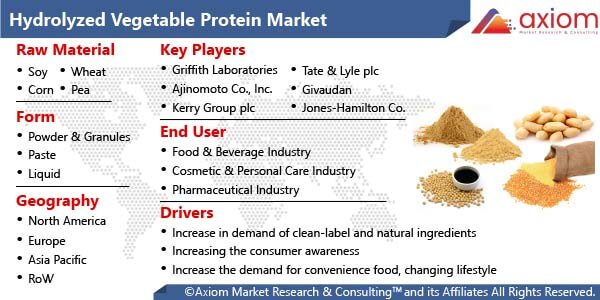Hydrolyzed protein is a protein that has been partially broken down into its component’s amino acid. Hydrolyzed vegetable protein is a natural and organic product which is rich in amino acid, minerals, micronutrients and it is particularly used to round off the taste of soup, sauces, fishes, meat product, snacks, veggie burgers, and processed food. It is considered a natural additive. These proteins are used to restore and add flavor to the processed food product during canning, freezing, or drying. The growing consumer demand for plant-based hydrolyzed protein over animal base hydrolyzed protein has driven the growth of the market for hydrolyzed vegetable protein. Liquid hydrolyzed protein contains 55% of water, 16% of salt, 25% organic substances (including 20% of protein), and 3% of nitrogen. It is not allergenic, as proteins are degraded into simple amino acids which are not likely to trigger an allergic reaction.
Market Dynamics – Hydrolysed Vegetable Protein Market
Factors such as an increase in demand for clean-label and natural ingredients, and increasing consumer awareness about the ill effects related to savory ingredients. Increasing demand for convenience food, changing lifestyle, and untapped potential in the developing Asia Pacific countries are a few other growth factors. As it helps to enhance the flavor of the processed food, it is also considered as the most sustainable protein ingredient which is further favoring the growth of the market. However, the availability of monosodium glutamate (MSG) in hydrolysed vegetable protein is expected to restrain the market growth over the forecast period.
ECONOMIC IMPACT OF COVID 19 ON HYDROLYSED VEGETABLE PROTEIN MARKET
The exclusive COVID 19 impact analysis provides an analysis of micro and macro-economic factors on the hydrolyzed vegetable protein market. Also, complete analysis of changes on healthcare expenditure, economic and international policies on supply and demand side. The report also studies the impact of the pandemic on global economies, international trade, business investments, GDP, and marketing strategies of key players present in the market. The demand for functional foods and nutraceuticals is anticipated to witness a mounting surge owing to consumers opting for immunity boosting supplements during the COVID-19 outbreak. Moreover, a deterioration in the consumption of meat, poultry, and seafood products across the globe is predicted to upsurge the demand for plant-based protein supplements in the near future.
HYDROLYZED VEGETABLE PROTEIN MARKET - SEGMENTAL OVERVIEW
The study analyzed the global hydrolyzed vegetable protein market based on source, application, form, and geography
HYDROLYZED VEGETABLE PROTEIN MARKET BY SOURCE
Soy, rapeseed, corn, rice, pea, and wheat are the sources of hydrolyzed vegetable protein. The soy segment of the HVP market is anticipated to gain substantial market share. Soy proteins are a very important protein source for human beings and livestock. Enzymatic hydrolysis of soy protein can enhance or reduce its functional properties and improve its nutritious value. Soy protein hydrolysates were primarily used as functional food ingredients, flavor, and nutritious enhancers, protein substitutes, and clinical products.
HYDROLYZED VEGETABLE PROTEIN MARKET BY APPLICATION
The market finds application in food products and functional beverages. Food products further get segmented into food & beverages, bakery & confectionery, and other food products. The food and beverage industry is expected to dominate the HVP market share during the forecast period. Proteins are nutritionally a source of energy and amino acid. The role of proteins in the diet as physiologically active components has been increasingly acknowledged. Many dietary proteins possess specific biological properties that make these components potential ingredients of functional or health-promoting foods.
HYDROLYZED VEGETABLE PROTEIN MARKET BY GEOGRAPHY
The Asia Pacific dominates the hydrolyzed vegetable protein market, followed by North America, and is expected to account for a major share during the forecast period. Asia Pacific is expected to register a CAGR of 6.9% during the forecast period. In the North American region, the United States dominates the market, followed by Canada. In the Asia Pacific region, China and India are expected to account for substantial growth, due to the increased demand for nutritional food among the consumers, while in South America, Brazil is expected to register the fastest growth.
HYDROLYZED VEGETABLE PROTEIN MARKET KEY PLAYERS
The key competitor of the market includes Astron Chemicals S.A., Jones Hamilton Co., McRitz International corporation, Good Food, Inc., Mishimoto Foods products Co. Ltd., Dien Inc., Innova Flavors, Unitechem Co., Ltd, Kerry Group Plc, Brolite Product Co. Inc., among others.











